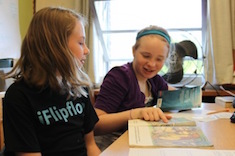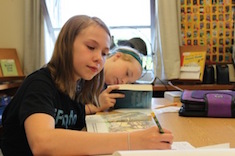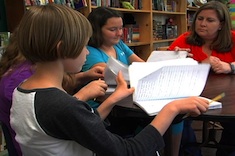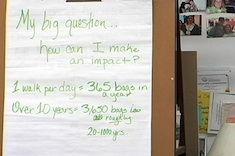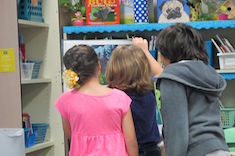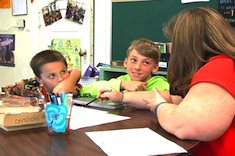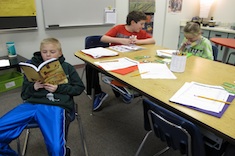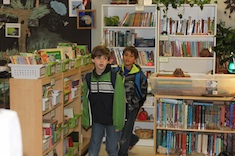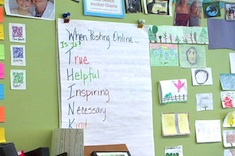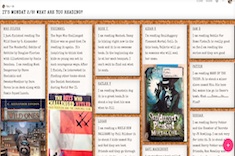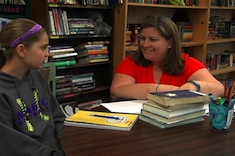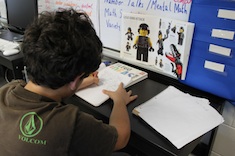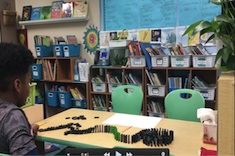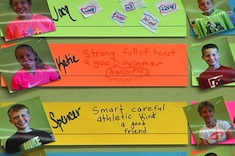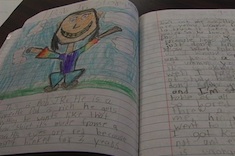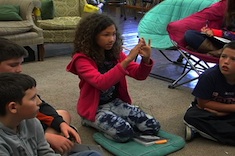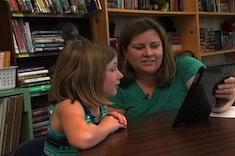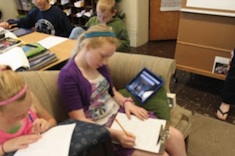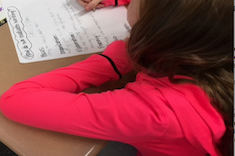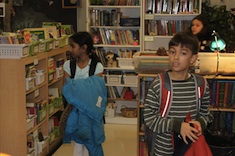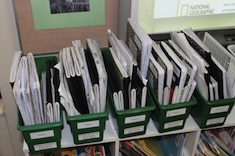5th
Latest Content
Research Through Picture Books
Katherine Sokolowski explains how picture books can be a potent tool for teaching intermediate students research skills.
Supporting Introverts in Fifth Grade
Katherine Sokolowski was that shy child hiding behind a tall classmate in the back of the room when she was a student. As a teacher, she makes sure there are many ways she helps bring out the voices of introverts in her fifth-grade classroom.
Environmental Group Notes
Katherine Sokolowski meets briefly with a group of fifth-grade girls to go through the notes they are taking for their environmental studies project and talk through next steps.
Free-Range Learning with Nonfiction Part 2: Infographics and Maps
Andrea Smith shares the final installment of her series on the value of free-range learning in helping students explore nonfiction.
Minilesson on Facts and Sources
Katherine Sokolowski presents a minilesson on ferreting out facts while completing independent research projects.
Free Range Learning with Nonfiction (Part 1)
Andrea Smith's students explore nonfiction through free-range roaming. She explains how she sets up expectations and resources early in the year in this first installment of a two-part series.
Teaching Students How to Give Revision Suggestions
Franki Sibberson shares a lesson progression to help students learn how to give helpful revision feedback. She uses online videos and resources to support her work.
The Power of Group Conferences in Fifth Grade
Katherine Sokolowski explains why group conferences can be a powerful tool for building a reading community. The article includes a video of a group conference in her fifth-grade classroom.
An Identity of Success
Mary Lee Hahn is a bit flummoxed when a parent asks about her management system at an open house. The experience sparks reflection on what makes a classroom community gel.
Loving Books or Reading?
Justin Stygles wonders why a love of books doesn't necessarily translate into a love of reading for his fifth and sixth graders.
Teaching Revision Strategies: Introduction and Modeling
Heather Rader shares a process for teaching peer editing and revision skills that helps students learn how to assist each other kindly during writing workshop. This is the first video in a three-part series.
Teaching Revision Strategies: Partner Work
Partners confer over revision in fifth grade in this second installment of a three-part video series.
Guidelines for Posting Online
Katherine Sokolowski describes a wall display with guidelines to ensure students are respectful and aware of the pitfalls of posting online.
Padlet Possibilities
Katherine Sokolowski finds that electronic charting of learning with Padlet has almost endless possibilities for use in her fifth-grade classroom.
Adding “Girly” Books to a Next-Read Stack
Katherine Sokolowski helps a fifth grader add more "girly" books to her next-read stack.
Mentors for Process and Habits
Ruth Ayres shares some of her favorite mentors and mentor texts for developing good writing processes and habits.
Introducing the Classroom Library
Andrea Smith shares a sequence of lessons she uses to introduce the classroom library to her fourth-grade students.
Student Interest Board
Katherine Sokolowski shares a wall display from her fifth graders that students build to celebrate who they are and people they love from home.
Conferring with Ben: Brainstorming Writing Topics and Genres
Katherine Sokolowski helps fifth grader Ben brainstorm ideas for writing, and in the process encourages him to try a new genre.
Nonfiction Research Group in Fifth Grade
Katherine Sokolowski meets with a group of fifth graders who are all researching the use of nets in fishing and the environmental effects of the process. She works to build connections among classmates as well as research skills.
Digging into Research Questions
Melanie Meehan explains how helping students deepen their questioning strategies leads to more thoughtful research projects.
#articleaday
Justin Stygles uses a daily nonfiction article activity as a way to build interest in nonfiction short texts, especially among reluctant readers in his classroom.
Tweeting a Favorite Author
Katherine Sokolowski helps one of her fifth-grade students compose a tweet to a favorite author.
Revising Weekly Reflections
Katherine Sokolowski revises the weekly reflection form her fifth graders use to ensure everyone is tracking goals, progress, and expectations.
Strategies for Elaboration in Opinion Writing
Melanie Meehan works with fifth graders who are struggling to elaborate on themes in their opinion writing.
Student Self-Assessment Strategies
Melanie Meehan works with fifth graders to help them create their own set of indicators of success in a writing unit.
Read Alouds and Standards
Maria Caplin explains how read alouds do double duty in her fifth-grade classroom, as they help build a love for story and help students master key literacy and content area standards.
What’s a Great Workshop Day?
Mary Lee Hahn considers how the success of any day has to integrate observations from conferring, lessons, and share sessions.
Planning and the Tuesday Effect
Mary Lee Hahn realizes how much a workshop approach has changed her planning process and comfort level with the unexpected.
Wonder and React
How do you scaffold students for independent work? Melanie Meehan finds Wonder and React is a great strategy to use with fifth graders during an information writing unit.
Browse Content By
Type
Category
- Assessment Tools
- Big Fresh Archives
- Booklists
- Choice Numeracy
- Classroom Design
- Common Core
- Community Building
- Conferring
- Content Literacy
- Digital Literacy
- English Language Learners
- Equity
- Family Relations
- Free Samples
- Guiding Groups
- Leadership
- Literacy Coaches
- Mentor Texts
- Minilessons
- New Teacher Mentors
- Podcasts
- Poetry
- Quote Collections
- Reading Strategies
- Self Care
- Struggling and Striving Learners
- Talking and Listening
- Teacher Study Groups
- Teaching Reading
- Teaching Writing
- Word Study and Vocabulary
Author
- Melissa Quimby
- Nawal Qarooni
- Gwen Blumberg
- Julie Cox
- The Lead Learners
- Hannah Tills
- Josie Stewart
- Ruth Metcalfe
- Mallory Messenger
- Becca Burk
- Jodie Bailey
- Vivian Chen
- Mary Brower
- Tiffany Abbott Fuller
- Stephanie Affinito
- Ruth Ayres
- Leigh Anne Eck
- Heather Fisher
- Shari Frost
- Julie Johnson
- Suzy Kaback
- Gigi McAllister
- Shirl McPhillips
- Melanie Meehan
- Cathy Mere
- Debbie Miller
- Tara Barnett and Kate Mills
- Tammy Mulligan
- Dana Murphy
- Bitsy Parks
- David Pittman
- Brenda Power
- Heather Rader
- Matt Renwick
- Mandy Robek
- Christy Rush-Levine
- Gretchen Schroeder
- Jen Schwanke
- Brian Sepe
- Katherine Sokolowski
- Stella Villalba
- Jennifer Vincent
Grade Level
Choice Literacy Membership
Articles
Get full access to all Choice Literacy article content
Videos
Get full access to all Choice Literacy video content
Courses
Access Choice Literacy course curriculum and training

